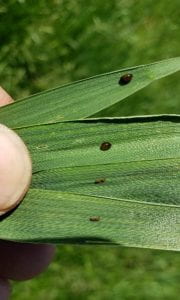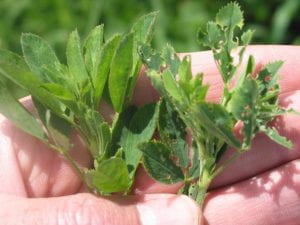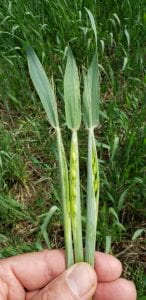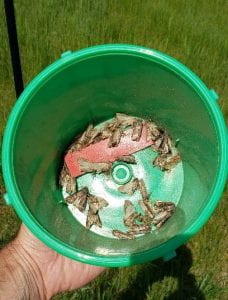
Cereal Leaf Beetle Eggs Have Hatched
It was very easy to find small Cereal Leaf Beetle (CLB) larvae in wheat fields this week. Larvae are shiny and black and almost look slug-like. They cover themselves in their own excrement and are actually pale orange when clean (after a rain). They feed on the green epidermis of the leaf and their damage results in a windowpane appearance as the leaves have strips of white. I also saw lot of adults still laying eggs. Threshold is three eggs and larvae per plant or one larva per flag leaf.
Watch for Alfalfa Weevil Larvae in Second Cut Regrowth

A lot of alfalfa hit the ground this week. As we mentioned last week, there were a high number of fields that were at or exceeded the economic threshold for injury. I’m sure there were some cutter bars loaded with larvae! Many of these larvae were not at the final instar where they do 80% of their feeding. The second cut regrowth really needs to be monitored. If you feel the alfalfa is not growing and just standing still, you better take a closer look. Treatment threshold is 50% tip feeding. Randomly pick 50 stems and count the number with feeding damage. You do not have to actually look for the larvae. If 25 of those 50 stems are positive for damage, you are at 50% and an insecticide application is warranted.

Winter Wheat Starting to Head
Most of our winter wheat started to head this week. Most of the fields I saw were at Feekes 10.1 (Awns pushing out of the boot). It is time to get ready to apply a fungicide as full head emergence is not far away and flowering will begin. Fungicides applications at flowering (anthesis) of Caramba, Prosaro, or Miravis Ace will be crucial in suppressing Fusarium head scab. These fungicides also the protect upper leaves against fungal leaf blotches, powdery mildew, and rusts.
Time to Scout for Black Cutworms Cutting Corn

Large numbers of black cutworms continue to fly into NY after each storm event. Three of our six traps had significant flights this week. Based on the degree days accumulated since our first significant flight on April 27, most of the NWNY region will hit 300 DD by Sunday. This means that some larvae will be large enough to cut corn plants. Lots of corn has emerged and is vulnerable. Time to start looking for signs of BCW feeding. This means chewed off leaves, wilting, cut and missing plants.
If 3 to 5% of the plants are missing or cut, spraying with an insecticide is warranted. Remember, BCW are nocturnal feeders and hide below ground during the day. The NWNY team has a good video on how to scout for BCW damage and find the culprit.


- Egg hatch around 90 Degree Days
- Plant cutting around 300 Degree Days
- Degree Day data from Network for Environment and Weather Applications, NEWA & CLIMOD 2



